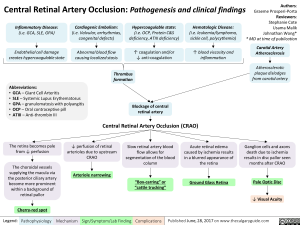Central Retinal Artery Occlusion: Pathogenesis and clinical findings
Inflammatory Disease: Cardiogenic Embolism: Hypercoagulable state: Hematologic Disease: (i.e. GCA, SLE, GPA) (i.e. Valvular, arrhythmias, congenital defects) (i.e. OCP, Protein C&S deficiency, ATIII deficiency) (i.e. leukemia/lymphoma, sickle cell, polycythemia) Endothelial cell damage Abnormal blood flow 1` coagulation and/or 1 blood viscosity and creates hypercoagulable state causing localized stasis 4, anti-coagulation inflammation
Abbreviations: • GCA — Giant Cell Arteritis • SLE — Systemic Lupus Erythematosus • GPA — granulomatosis with polyangitis • OCP — Oral contraceptive pill • ATIII — Anti-thrombin Ill
Thrombus formation
Blockage of central retinal artery
Central Retinal Artery Occlusion (CRAO)
Authors: Graeme Prosperi-Porta Reviewers: Stephanie Cote Usama Malik Johnathan Wong* * MD at time of publication Carotid Artery Atherosclerosis
Atherosclerotic plaque dislodges from carotid artery
The retina becomes pale 4, perfusion of retinal Slow retinal artery blood Acute retinal edema Ganglion cells and axons from NI, perfusion arterioles due to upstream flow allows for caused by ischemia results death due to ischemia CRAO segmentation of the blood column in a blurred appearance of the retina results in disc pallor seen months after CRAO The choroidal vessels supplying the macula via the posterior ciliary artery become more prominent within a background of retinal pallor “Box-carring” or Pale Optic Disc Arteriole narrowing Ground Glass Retina “cattle trucking”
Cherry-red spot
4, Visual Acuity
Foundations
Systems
Other Languages
Ophthalmology Retina Central Retinal Artery Occlusion: Pathogenesis and clinical findings central-retinal-artery-occlusion-pathogenesis-and-clinical-findings

